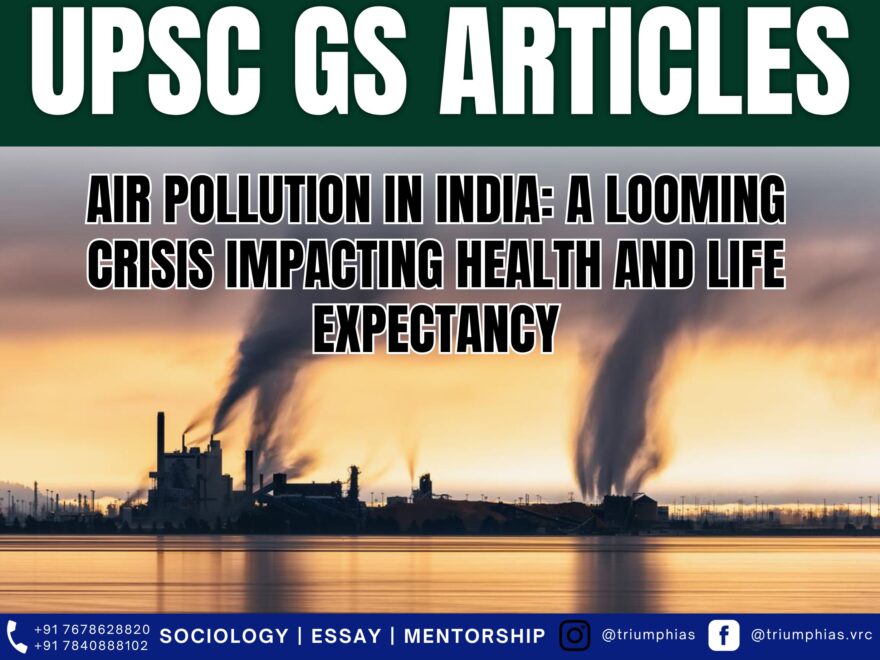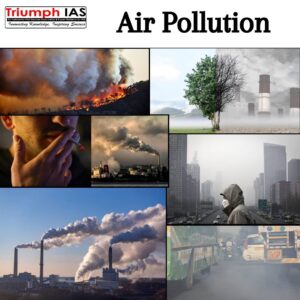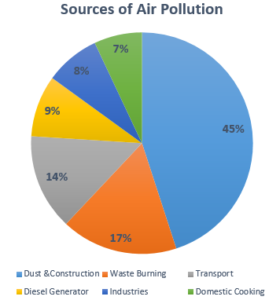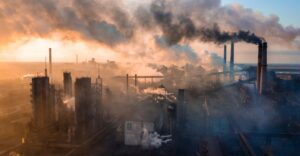Air Pollution: A cause of concern for growth
(Relevant for General Studies Paper Prelims/Mains)
A global report has estimated that the noxious combination of vapours in Delhi is reducing a resident’s life expectancy by nearly 12 years. This report paints a bleak picture of administrative neglect, as the air quality worsens year after year, with interventions only occurring when it becomes almost impossible to breathe. According to the Air Quality Life Index 2023 report by the University of Chicago’s Energy Policy Institute (EPIC), Delhi, Noida, and Gurugram ranked among the worst performers worldwide. In India, the northern plains, where approximately 40% of the population resides, were identified as the poorest performers, resulting in an average loss of about eight years of life expectancy due to pollution.
Air pollution
Air pollution refers to the contamination of the atmosphere by substances that are detrimental to the health of humans and other living organisms, as well as harmful to the climate and materials.
Some of the common air pollutants include:
- Particulate Matter (PM10 and PM2.5): These are minuscule solid or liquid particles suspended in the air. They can originate from natural sources like dust, pollen, and volcanic eruptions, or result from human activities such as burning fossil fuels, wood, and waste, as well as industrial processes like mining, construction, and agriculture. PM2.5 is particularly hazardous as it can infiltrate deeper into the lungs and bloodstream, leading to more significant health issues.
- Ozone (O3): This is a gas formed when sunlight reacts with nitrogen oxides and volatile organic compounds (VOCs) in the air. Ozone’s impact can be beneficial or detrimental, depending on its location in the atmosphere. In the stratosphere, it shields the Earth from harmful ultraviolet (UV) rays. However, in the troposphere, it becomes a pollutant that can irritate the eyes, nose, and throat, harm the lungs, and cause respiratory ailments.
- Nitrogen Dioxide (NO2): This gas is produced when nitrogen oxides (NOx) react with oxygen in the air. NOx emissions result from combustion processes like those in motor vehicles, power plants, and industrial boilers. NO2 can lead to respiratory issues such as coughing, wheezing, and shortness of breath, while increasing susceptibility to infections and allergies. NO2 also contributes to the formation of ozone and particulate matter in the air.
- Carbon Monoxide (CO): A colorless, odorless gas generated by incomplete combustion of carbon-based fuels such as gasoline, diesel, coal, wood, and charcoal. CO can diminish the supply of oxygen to vital organs and tissues, especially the heart and brain. Symptoms of CO exposure include headaches, dizziness, nausea, fatigue, confusion, and, in severe cases, death.
- Sulfur Dioxide (SO2): This gas arises when sulfur-containing fuels like coal and oil are burned. SO2 can cause eye, nose, and throat irritation, coughing, breathing difficulties, and asthma attacks. Additionally, SO2 reacts with water vapour and other substances in the atmosphere to form acid rain, which can harm plants, soil, water, and structures.
- Water Vapour: Water vapour is the most abundant greenhouse gas in the atmosphere and plays a critical role in regulating Earth’s climate. It is not a direct pollutant as it is part of the natural water cycle. However, water vapour becomes problematic when it interacts with other greenhouse gases like carbon dioxide and methane, amplifying their warming effects. This phenomenon is known as the water vapour feedback loop.
Primary Causes of Air Pollution in India
Sources of Air Pollution in India:
- Vehicle Emissions: Vehicles represent a significant contributor to air pollution in India, particularly in urban areas. According to research by the Centre for Science and Environment (CSE), vehicles are responsible for 40% of PM2.5 emissions in Delhi, 30% in Mumbai, 28% in Kolkata, and 20% in Bengaluru.
- Industrial Emissions: Industries also play a substantial role in India’s air pollution, especially in the northern and eastern regions. A report by Greenpeace India highlighted that 139 out of 287 coal-based thermal power plants in India exceeded emission standards set by the Ministry of Environment in 2019. These plants released harmful substances such as sulfur dioxide, nitrogen oxides, carbon monoxide, lead, mercury, and volatile organic compounds (VOCs), contributing to issues like acid rain, smog, climate change, and health problems.
- Fossil Fuel Combustion: Power plants, factories, and households using coal, oil, or natural gas as fuel are additional sources of air pollution in India, emitting greenhouse gases. India ranks as the world’s third-largest CO2 emitter, trailing China and the United States, as per the World Bank Group.
- Agricultural Practices: Agricultural activities, including the burning of crop residues, fertilizer and pesticide use, and livestock farming, also generate air pollution in India. A study by IIT Delhi found that crop burning accounted for 44% of Delhi’s PM2.5 levels during the peak pollution season in November 2019. Crop burning releases smoke, dust, ammonia, methane, and nitrous oxide into the atmosphere, impacting soil quality, biodiversity, and human health.
- Indoor Air Pollution: The use of biomass fuels like wood, dung, or charcoal for cooking in rural areas contributes to indoor air pollution in India. Over 800 million people in India rely on solid fuels for cooking, as reported by the World Health Organization (WHO). These fuels produce indoor air pollutants at concentrations five times higher than coal, leading to issues such as eye irritation, lung infections, chronic obstructive pulmonary disease (COPD), and premature deaths.
- Waste Burning: Many individuals in India dispose of household waste by burning it in open areas, releasing toxic chemicals and dioxins into the air, posing cancer and other health risks. According to a study by The Energy and Resources Institute (TERI), waste burning contributed to 29% of Delhi’s PM10 levels during the winter season in 2018. Waste burning also emits black carbon, a potent short-lived climate pollutant that accelerates global warming.
- Slaughter Industry: The release of methane from the digestive processes of ruminant animals like cows and buffaloes is a substantial contributor to greenhouse gas emissions. Methane has a global warming potential 28 times higher than carbon dioxide over a 100-year period. Additionally, the decomposition of animal waste and carcasses emits pollutants like ammonia, hydrogen sulfide, and volatile organic compounds. The burning of animal waste and carcasses further releases particulate matter, carbon monoxide, nitrogen oxides, and other harmful substances into the atmosphere. According to a report by the Centre for Science and Environment (CSE), India’s slaughter industry generates approximately 2.7 million tonnes of solid waste and 3.6 billion liters of wastewater annually. The report also reveals that most slaughterhouses lack proper waste management systems and pollution control devices, frequently violating environmental regulations and norms.
Challenges in Addressing Air Pollution:
- Weak Implementation and Adherence to Existing Regulations: Ineffective enforcement and compliance with current regulations and standards designed to prevent or penalize pollution-causing activities.
- Insufficient Funding and Incentives for Clean Technologies: Limited financial support and incentives for the adoption of clean technologies and practices capable of reducing emissions across various sectors.
- Limited Public Awareness and Engagement: Inadequate awareness and involvement of the public and other stakeholders regarding the causes, impacts, and remedies for air pollution.
- Lack of Capacity and Expertise: Inadequate expertise and capacity within relevant institutions and stakeholders responsible for formulating, executing, and assessing effective air pollution policies and initiatives.
- Vulnerability to Climate Change: Inadequate preparedness and resilience to changing climatic conditions and extreme weather events that can exacerbate air pollution levels and its consequences.
- Insufficient Research and Innovation: A scarcity of research and innovation focused on generating evidence-based solutions and technologies for both mitigating and adapting to air pollution.
- Lagging Regulation and Funding for Clean Technologies: Clean technologies have evolved rapidly, but regulatory frameworks and financial support mechanisms have not kept pace.
- Inefficient Transportation and Land Use: Inefficient transportation systems and inadequate land use planning patterns that contribute to pollution.
- Presence of Unregulated Small-Scale Industries: The existence of numerous unregulated small-scale industries, including brick kilns, metal smelters, foundries, tanneries, etc., operating without proper environmental permits or controls.
What are possible options?
- Vertical Forests: The construction of skyscrapers adorned with greenery serves a dual purpose: absorbing carbon dioxide, producing oxygen, and providing a habitat for biodiversity. These vertical forests act as natural air purifiers while enhancing the city’s aesthetic appeal.
- Air Purifiers and Smog Towers: The installation of air purifiers and smog towers equipped with technologies like electrostatic precipitation, activated carbon, or HEPA filters effectively filters airborne particulates, thereby improving air quality.
- Promotion of Low-Carbon Technologies: The development and promotion of low-carbon technologies such as solar panels, hydrogen fuel cells, biofuels, wind turbines, biogas plants, and electric vehicles reduce reliance on fossil fuels. These technologies also offer clean, renewable energy sources, generate green employment opportunities, and mitigate climate change.
- Urban Green Spaces: The creation of urban green spaces like parks, gardens, and rooftop gardens not only enhances air quality but also mitigates the heat island effect and provides recreational benefits. These green spaces boost biodiversity, sequester carbon, and enhance the city’s overall aesthetics.
- Congestion Pricing and Low Emission Zones: The implementation of congestion pricing or low emission zones charges vehicles entering specific city areas or restricts high-polluting vehicle entry. These policies incentivize cleaner transportation options and reduce traffic congestion and emissions in city centers.
- Biomass Briquettes/Pellets: Biomass pellets, derived from agricultural or forest residues, offer an affordable and efficient fuel source for rural households.
- Biomimicry: Designing buildings and materials inspired by natural air purification processes, such as the Eastgate Centre in Zimbabwe, which mimics termite mound-inspired passive cooling. Biomimicry can also drive innovations like self-cleaning paints, smog-absorbing concrete, and artificial leaves.
- Support for Innovative Solutions: Backing social enterprises and startups like Graviky Labs, Chakr Innovation, and HelpUsGreen, which offer innovative air pollution solutions. For instance, Graviky Labs’ Kaalink captures pollution from generators and transforms it into usable ink.
- Street Furniture for Pollution Mitigation: Installing street furniture with pollution-fighting capabilities to counter limited tree-planting space in urban areas. Green City Solutions, for example, places moss-covered tree benches in key landmarks across European cities to absorb pollutants.
- Air Purifying Helmets: Helmets equipped with built-in air purifiers that filter harmful pollutants from the air, designed primarily for bikers exposed to high levels of road pollution. Delhi-based startup Shellios is testing a prototype.
- Differential Toll Treatment: A policy that imposes higher toll fees on vehicles emitting greater pollutants, such as diesel trucks and older cars. This approach encourages drivers to opt for cleaner vehicles or public transportation, ultimately reducing traffic congestion and emissions.
- Hot Lanes: Reserved lanes for vehicles with high occupancy, such as carpooling or public buses, promoting ride-sharing and mass transit use, reducing road congestion, emissions, travel time, and fuel consumption for users.
In India, more basic livelihood issues often dominate the electoral discourse, allowing the authorities to escape scrutiny on the pollution front. But no country has progressed economically without caring for the health of its citizens. The government needs to take the health hazards of pollution seriously. The first step on this journey would be to delink air action plans from the winter and develop holistic year-long strategies.
Reference The Hindu
Related Blogs…
 |
 |
Frequently Asked Questions:
Question: Examine the socio-economic factors contributing to air pollution in India.
Answer: Socio-economic factors such as industrialization, vehicular growth, and agricultural practices contribute to air pollution. The lack of public awareness and insufficient governance also exacerbate the issue.
Question: How does air pollution impact social inequality in India?
Answer: Air pollution disproportionately affects marginalized communities who often reside in highly polluted areas and lack access to healthcare, deepening existing social inequalities.
Question: Discuss the role of public policy in mitigating air pollution in India.
Answer: Public policy can play a crucial role through regulations, incentivizing green technologies, and raising public awareness. However, challenges such as weak implementation and limited funding often hinder effective outcomes.
Question: What is the impact of air pollution on public health in India, particularly in cities like Delhi?
Answer: Air pollution significantly impacts public health by reducing life expectancy and causing respiratory diseases, heart conditions, and other health issues, particularly in highly polluted cities like Delhi.
Question: How can innovative solutions like vertical forests and smog towers contribute to reducing air pollution in urban areas?
Answer: Innovative solutions like vertical forests absorb CO2 and produce oxygen, while smog towers filter airborne particulates, both contributing to improved air quality in urban areas.
GS Related Practices Questions…
To master these intricacies and fare well in the Sociology Optional Syllabus, aspiring sociologists might benefit from guidance by the Best Sociology Optional Teacher and participation in the Best Sociology Optional Coaching. These avenues provide comprehensive assistance, ensuring a solid understanding of sociology’s diverse methodologies and techniques.
Air Pollution, Life Expectancy, Public Health, Delhi Pollution, Vehicle Emissions, India, Industrial Emissions, Green Technologies, Air Quality, Climate Change, Public Policy, Government Action, Pollution Solutions, Agriculture, Indoor Air Pollution.

Why Vikash Ranjan’s Classes for Sociology?
Proper guidance and assistance are required to learn the skill of interlinking current happenings with the conventional topics. VIKASH RANJAN SIR at TRIUMPH IAS guides students according to the Recent Trends of UPSC, making him the Best Sociology Teacher for Sociology Optional UPSC.
At Triumph IAS, the Best Sociology Optional Coaching platform, we not only provide the best study material and applied classes for Sociology for IAS but also conduct regular assignments and class tests to assess candidates’ writing skills and understanding of the subject.
Choose The Best Sociology Optional Teacher for IAS Preparation?
At the beginning of the journey for Civil Services Examination preparation, many students face a pivotal decision – selecting their optional subject. Questions such as “which optional subject is the best?” and “which optional subject is the most scoring?” frequently come to mind. Choosing the right optional subject, like choosing the best sociology optional teacher, is a subjective yet vital step that requires a thoughtful decision based on facts. A misstep in this crucial decision can indeed prove disastrous.
Ever since the exam pattern was revamped in 2013, the UPSC has eliminated the need for a second optional subject. Now, candidates have to choose only one optional subject for the UPSC Mains, which has two papers of 250 marks each. One of the compelling choices for many has been the sociology optional. However, it’s strongly advised to decide on your optional subject for mains well ahead of time to get sufficient time to complete the syllabus. After all, most students score similarly in General Studies Papers; it’s the score in the optional subject & essay that contributes significantly to the final selection.
“A sound strategy does not rely solely on the popular
Opinion of toppers or famous YouTubers cum teachers.”
It requires understanding one’s ability, interest, and the relevance of the subject, not just for the exam but also for life in general. Hence, when selecting the best sociology teacher, one must consider the usefulness of sociology optional coaching in General Studies, Essay, and Personality Test.
The choice of the optional subject should be based on objective criteria, such as the nature, scope, and size of the syllabus, uniformity and stability in the question pattern, relevance of the syllabic content in daily life in society, and the availability of study material and guidance. For example, choosing the best sociology optional coaching can ensure access to top-quality study materials and experienced teachers. Always remember, the approach of the UPSC optional subject differs from your academic studies of subjects. Therefore, before settling for sociology optional, you need to analyze the syllabus, previous years’ pattern, subject requirements (be it ideal, visionary, numerical, conceptual theoretical), and your comfort level with the subject.
This decision marks a critical point in your UPSC – CSE journey, potentially determining your success in a career in IAS/Civil Services. Therefore, it’s crucial to choose wisely, whether it’s the optional subject or the best sociology optional teacher. Always base your decision on accurate facts, and never let your emotional biases guide your choices. After all, the search for the best sociology optional coaching is about finding the perfect fit for your unique academic needs and aspirations.
To master these intricacies and fare well in the Sociology Optional Syllabus, aspiring sociologists might benefit from guidance by the Best Sociology Optional Teacher and participation in the Best Sociology Optional Coaching. These avenues provide comprehensive assistance, ensuring a solid understanding of sociology’s diverse methodologies and techniques. Sociology, Social theory, Best Sociology Optional Teacher, Best Sociology Optional Coaching, Sociology Optional Syllabus.
Best Sociology Optional Teacher, Sociology Syllabus, Sociology Optional, Sociology Optional Coaching, Best Sociology Optional Coaching, Best Sociology Teacher, Sociology Course, Sociology Teacher, Sociology Foundation, Sociology Foundation Course, Sociology Optional UPSC, Sociology for IAS,
Follow us :
🔎 https://www.instagram.com/triumphias
🔎https://www.youtube.com/c/TriumphIAS
https://t.me/VikashRanjanSociology
Find More Blogs
|
Scope of the subject and comparison with other social sciences |
|||
|
|
|
|
Modernity and social changes in Europe |




